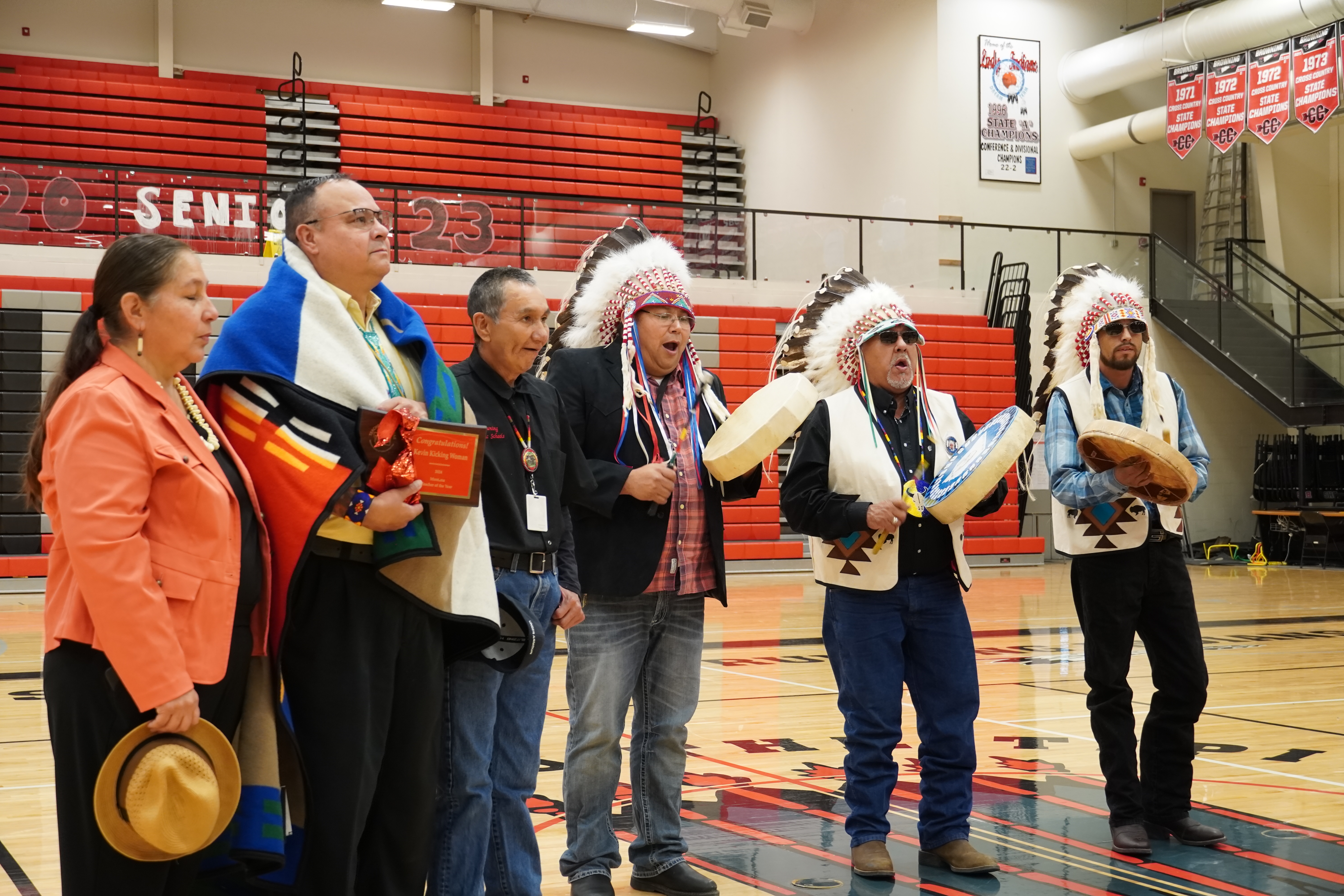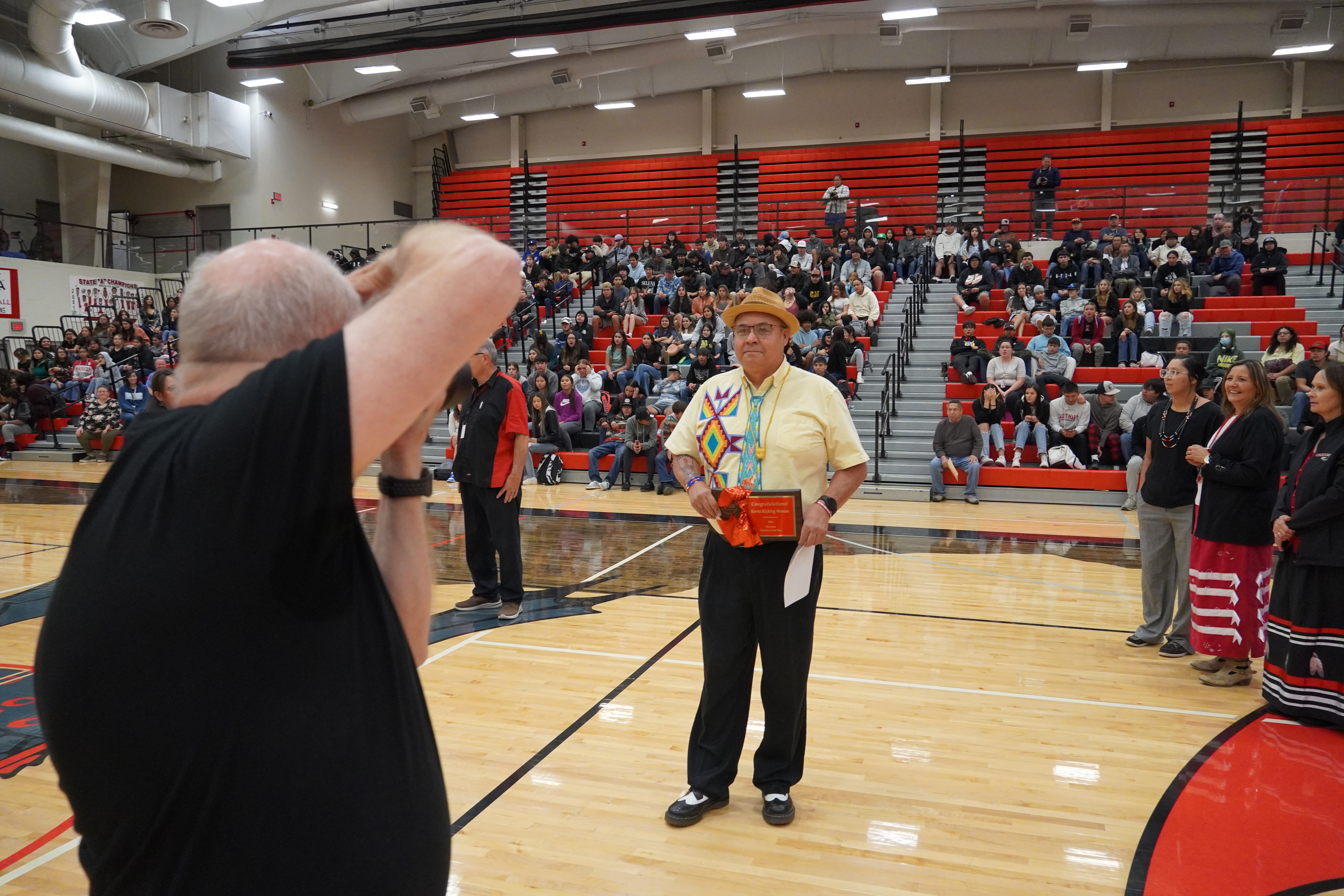NATIONAL MUSEUM OF THE AMERICAN INDIAN
Meet Montana’s Teacher of the Year: Kevin KickingWoman
It is very rare for an American Indian who has deep roots in his culture, to receive teaching recognition in formal education. Here is his story.
:focal(1000x1500:1001x1501)/https://tf-cmsv2-smithsonianmag-media.s3.amazonaws.com/filer_public/ca/3d/ca3dc759-aace-4484-8706-4d67596d4f21/kevin_kw_2.jpg)
“Since colonization began, Europeans who came to the Americas sought to eradicate Native traditions by forcing their system of mandatory formal education upon the tribes they encountered. Through this process, Christian and government boarding schools did much to eliminate Native languages and culture. Here is one success story honoring a tribal educator who is implementing modern curriculum to save his language.”
The 2023-24 Montana Teacher of the Year, Kevin KickingWoman, is from the Blackfeet Nation. KickingWoman served in the Navy for four years and was based on the USS Sacramento in Bremerton, Washington, with accommodations and main propulsion engineering certification. KickingWoman has a Class 7 teaching certification, qualifying him as a Blackfeet cultural teacher. He earned a bachelor’s degree in Native American studies and anthropology at the University of Montana in 2011 and a master’s in interdisciplinary studies from the University of Montana in 2013.
KickingWoman has dedicated his career to teaching, learning, and sharing knowledge. He began his nearly 25-year teaching career at Browning Middle School in Browning, Montana, then became the Indian Education Director at Heart Butte Public Schools, also in Montana. He later worked as the Bridges to the baccalaureate program coordinator while serving as an adjunct professor at the University of Montana.
Today, KickingWoman teaches Blackfeet language and culture in grades 9 through 12 at his alma mater, Browning High School. KickingWoman also practices Native ceremonies and traditions and is an active member of many of the tribal societies of the Blackfeet people. His passion for Native singing has brought him respect, acclaim, and knowledge. His singing, sharing and teaching has impacted and enriched many lives. Currently, KickingWoman and his wife Joni have five children and a granddaughter, Kookaakii, who is his pride and joy.
We interviewed Mr. KickingWoman about his heritage and how it has played an important role in his educational endeavors. Below are his answers:
Can you give us your Native name, its English translation and/or nickname?
My Indian name is Kookii. It means “Corner Post.”
What tribe are you and where do your people reside?
I am Aamsskáápi Piikáni. I come from the Southern Piikáni (Blackfeet people). I live in a little place called Ithonio (Browning, Montana). There are four bands of us. Three are in Canada divided by the 49th parallel. Those are the Aputsi Piikáni, the Kanai and the Siksika. And so were the Aamsskáápi Piikáni living down in the United States on about 1.5 million acres of original Blackfoot territory.
What cultural events do you participate in?
I participate in a lot. I am a keeper of songs. So, one of the major things that is coming up is when the first thunder happens. When that happens, we start to congregate and start calling each other that we need to get ready for a dance. And men and women that are making their vows, perhaps they’re sick during the year. So, they make their vows for healing and dance with a pipe. And then there is a series of songs that we have sung for thousands and thousands of years and still sung today. I participate in the Sundance. I do the Sweat Lodge. I do a lot of conducting those. And all through the years, the honoring of people, singing family songs, clan songs and society songs. One of the major events on the Blackfeet Reservation is the North American Indian Days, which happens in the second week of July. They have about six or seven hundred dancers, with about 30 to 40 drum groups that come. It’s a pretty big celebration. And I also do a lot with the Glacier National Park. I’m part of what is referred to as the Native Speaker series. It’s kind of new right now, and so we have about 15 speakers that go out and educate the public about Native philosophy and talk about Native culture.

What is a significant historical event that your tribe is most known for?
Again, North American Indian Days. I think it’s like the 75th annual anniversary. Also, every year we give remembrance to the 64th Flood that killed over 200 people as well as the Baker Massacre with is a big event at home where in 1870 around December, Major Eugene Baker led a massacre of over 270 Blackfeet women and children and so we commemorate that every December.
Why is your tribal language important to the continuance of your culture and traditions?
Languages and defining characters are who we are. I tell my students I am Aamsskáápi Piikáni and I speak Blackfoot. I literally feel that if you lose the language, you lose yourself. And that is why language is so important. Language also softens your heart. I really believe that looking through the lens of a Native speaker, you see a whole different context that you’re looking outside, or because everything’s alive. It’s anime. And so, it’s just a beautiful language. That’s something that resonates with people of all races.
Approximately how many members are there in your tribe and what percentage are fluent speakers?
We have 17,500 members. But there are only about 200 fluent speakers left. We are trying to change that.
How many students have you taught?
In my career? Wow, thousands I guess that come through the door. And my class load? I’m looking at 130 students a day because my class is an elective and so I have about 25 per class times seven periods.
How long have you been teaching?
Over my career of around 25 years, I kind of took some hiatuses. I served in the Navy and as a hot shot - fighting fires. But then I would go back to teaching. I think what really changed me is when I worked with a gentleman named Leon Rattler. He asked me to come down and work with some youth. In that little youth camp that we did in the summer, mainly to get into teaching and so ever since then at home they have a class seven teaching certification that language speakers can utilize. If you’re a speaker, you get it signed off by the tribal leadership and can teach the language. So, what I have found is it’s hard to go into a classroom without classroom management skills and what not. And so, I decided that I needed to go back to school and get all these tools.
/https://tf-cmsv2-smithsonianmag-media.s3.amazonaws.com/filer_public/27/c0/27c0c32d-bace-4f89-bd89-af6eb67a5df3/kevin_kw_1.jpg)
Are you a descendent of any important tribal leaders?
I am a descendent of Chief Nanastico, Chief Mountain Chief and Mountain Chief that go way back to the late 1700’s. Chief Mountain Chief was part of the Black Horse Society. There were a bunch of members and warriors in that society. But Chief Mountain Chief was very prevalent. And he had a son that he passed his name Mountain Chief to, who was very, very famous. You can Google him to see his picture.
What part of your tribal background inspired you to become an educator?
I harkened back to growing up in foster homes. There was a gentleman named Chief Earl Old Person who mentored my grandfather, George KickingWoman. Those two gentlemen were men you could ask them for anything, and they rarely ever said no. The humility that they walked with, I aspired to also walk with humility, to be generous every day, laugh and cry like they carried themselves. You could go up and ask them for advice on certain songs and they would take the time to help. They inspired me with their knowledge. They were like an encyclopedia. They inspired me to be a teacher because as Blackfeet, we have an obligation to give back with our knowledge because nothing was written and so like my grandpa used to say, “never be stingy because when you leave this earth, you take your knowledge with you. So, pass it on.” This is what inspires me to change the youth while also continuing to learn from the elders.
Were there any obstacles you faced as a Native that challenged you as an educator?
One of the major obstacles that I face is that my parents went to boarding schools. What I am finding is kids are searching for their cultural identity asking their selves who am I? It’s hard for them to find who they are because they are told it isn’t cool to be Native. When we try and teach our ways, you have other Natives say, “I don’t want my kids to learn that.” And so those are reasons why are kids are so lost. I believe the only way back is by learning our language and songs. I have found that the trauma that our kids have today, I almost think it’s a gene that is innate within us that we are fighting. Our people are asked, why don’t we get over it? An elder responded, “When you put it in perspective, our ceremonies are from the past and we need these ceremonies to heal the present so we can move forward into the future.” That’s the way I look at education. We need to go back to our ceremonies so we can feel it in the present. I feel bad for how our children are feeling now. They feel somewhat connected, without actually being connected.
How were you informed that you were Montana’s Teacher of the Year?
They kept it from me pretty good. It was funny because there were some fights in school the evening before. The next morning, I’m sitting in my classroom, and they call this assembly. I am not ready to go there, so I kept sitting for a while before I made my way to the assembly area. When I arrived, everyone including the principal are all sitting there waiting. Something didn’t seem right because they had a photographer there and I’m like, “We’re going to get in trouble, right? I still didn’t get what was going on until my family came in and superintendent called me forward. Then it dawned on me what was happening. To see my family there was the biggest surprise for me because I have a new granddaughter now and she won’t remember it, but I will. So that is how I found it so beautiful that my family and new granddaughter were able to share this special moment in time with me.”
What are some goals and objectives you have yet to achieve in your educational career?
One goal for me is to put out at least 20 fluent Blackfoot speakers through my tenure in grades 9 through 12. So that when they graduate, they will have the grounding and know what I know. One way of reaching these objectives is to implement a new Blackfoot writing system. The public schools have supported this and by doing so, are helping to standardize a uniform way of writing, and teaching the Blackfoot language so that each student at least learns to read it, write it, enunciate it and understand it.
Is there anything else you would like to add to this interview?
As I mentioned earlier, I grew up in foster homes with severe abuse and I also know the problems our kids face in our reservation. I try and make myself approachable to our kids and be someone that they can relate to. Part of the wisdom that I share is to not let hurt stand in your way. Always try hard and never give up. These are the types of encouragement that I share every day. I tell them, “Our ancestors suffered for you to be here today. So, the best thing you can do is do your best.”
/https://tf-cmsv2-smithsonianmag-media.s3.amazonaws.com/filer_public/16/fe/16fed325-6e86-4218-960c-3a809a8acc0d/kevin_kw_6.jpg)
